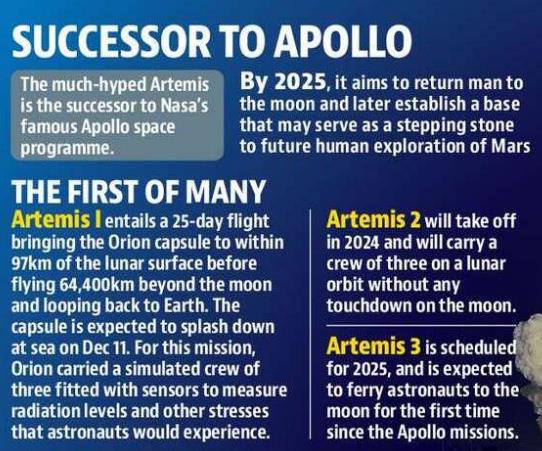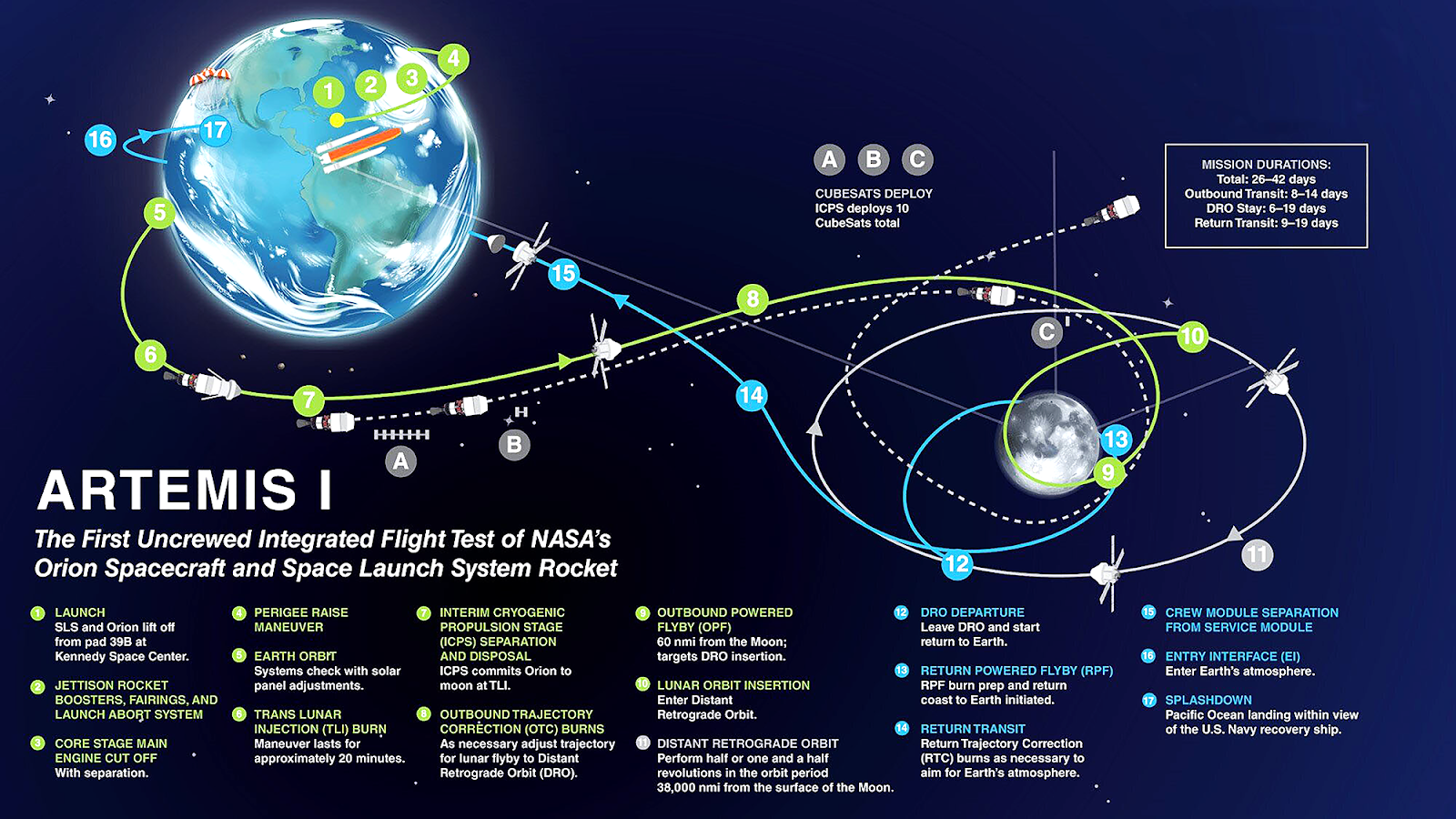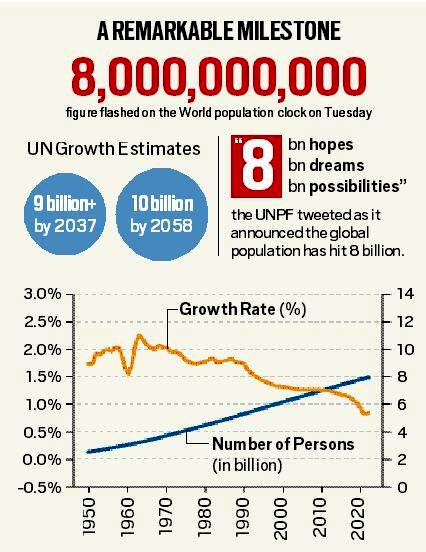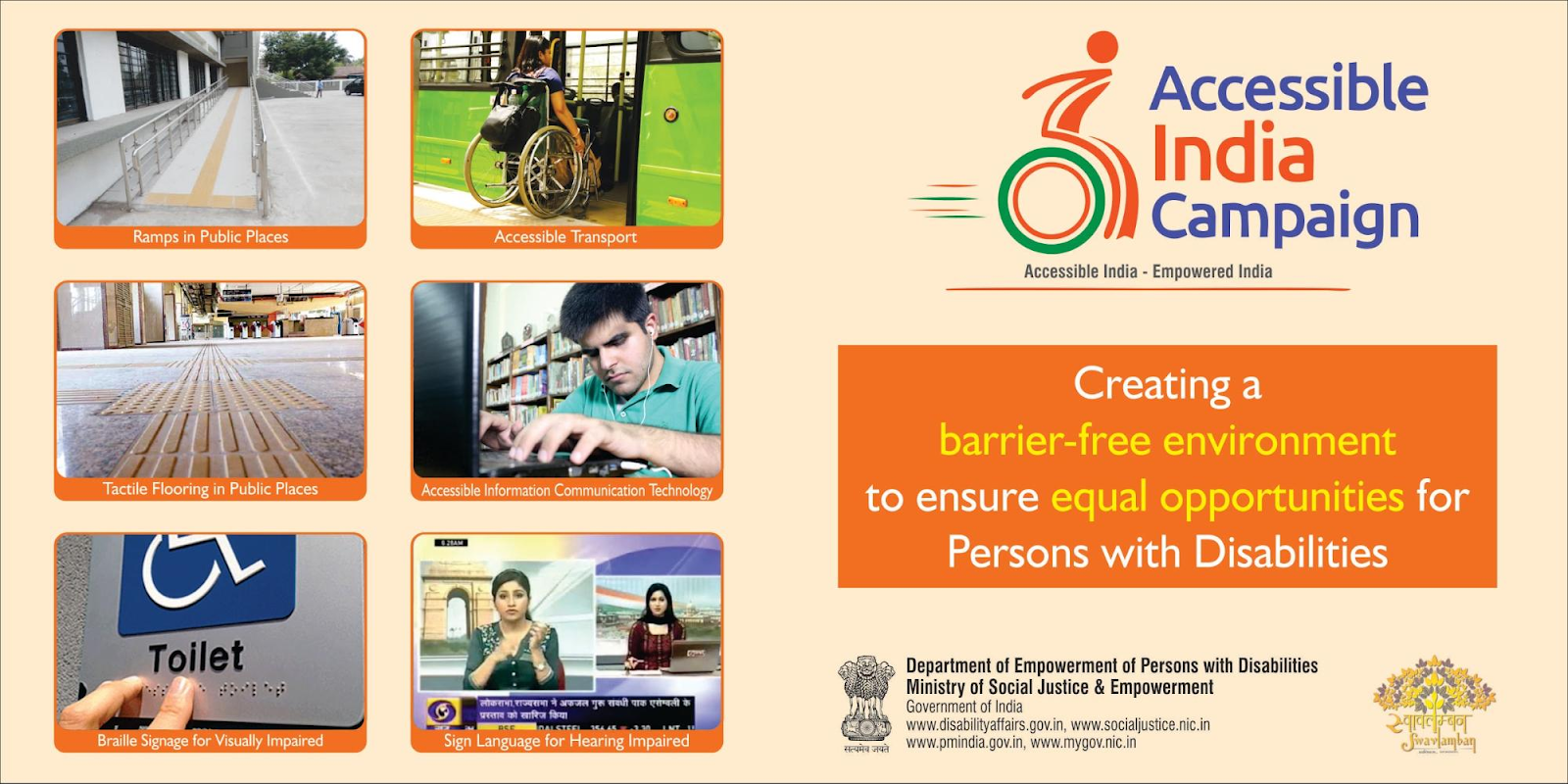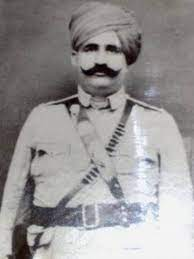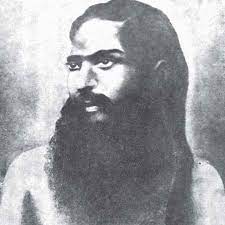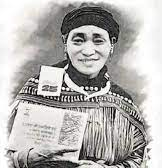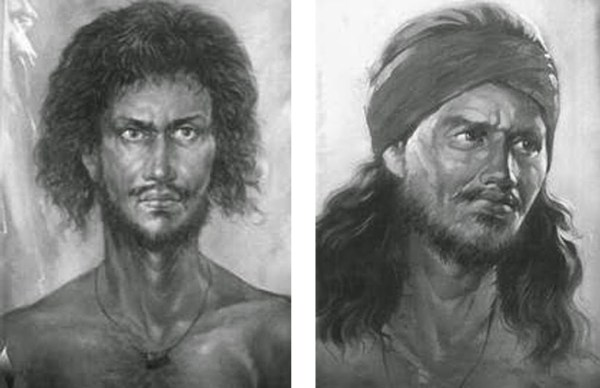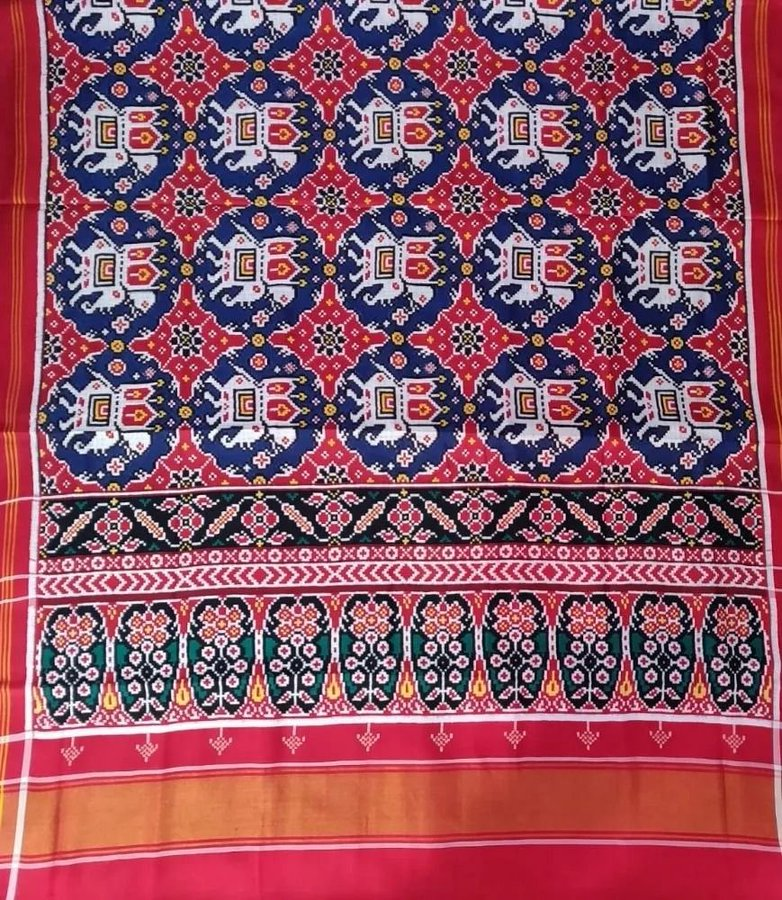Infographics
Science & Technology
Third Attempt for Artemis I
For Prelims: National Aeronautics and Space Administration (NASA), Artemis I, moon mission, Chandrayaan project, Indian Space Research Organisation (ISRO), History of Moon Exploration
For Mains: Space Exploration, Moon mission, Sending Humans on Moon.
Why in News?
National Aeronautics and Space Administration (NASA) has successfully launched its unmanned Moon mission Artemis I on 16th November 2022.
- After multiple delays caused by technological failures and natural disasters spread across two months, the Space Launch System (SLS) rocket has been lifted off from the Kennedy Space Centre in Cape Canaveral, Florida.
What is the Artemis I Mission?
- Artemis I is an uncrewed mission of NASA.
- Named after the sister of Apollo in Greek mythology, it is NASA's successor to the Apollo lunar missions from fifty years ago.
- It will test the agency’s Space Launch System (SLS) rocket and Orion crew capsule.
- The SLS is the largest new vertical launch system NASA has created since the Saturn V rockets used in the 1960s and 1970s.
- Artemis I is the first in a series of increasingly complex missions to build a long-term human presence at the Moon for decades to come.
- The primary goals for Artemis I are to demonstrate Orion’s systems in a spaceflight environment and ensure a safe re-entry, descent, splashdown, and recovery prior to the first flight with crew on Artemis II.
- It is only a lunar Orbiter mission even though, unlike most Orbiter missions, it has a return-to-Earth target.
What is the Importance of Artemis I Mission?
- Artemis I is the first step into that new space age of achieving the promise of transporting humans to new worlds, of landing and living on other planets, or maybe meeting aliens.
- The CubeSats it will carry are equipped with instruments meant for specific investigations and experiments, including searching for water in all forms and for hydrogen that can be utilised as a source of energy.
- Biology experiments will be carried out, and the impact of deep space atmosphere on humans will be investigated through the effect on dummy ‘passengers’ on-board Orion.
What are the Upcoming Artemis Missions?
- Artemis II:
- It will take off in 2024.
- Artemis II will have a crew aboard Orion and will be a test mission to confirm that all of the spacecraft’s systems will operate as designed when it has humans on board.
- But the Artemis II launch will be similar to that of Artemis I. A crew of four astronauts will be aboard Orion as it and ICPS orbit the Earth twice before moving to the direction of the Moon.
- Artemis III:
- It is scheduled for 2025, and is expected to ferry astronauts to the moon for the first time since the apollo missions.
What are India’s Moon Exploration Efforts?
- Chandrayaan 1:
- Chandrayaan-1 was India's first mission to Moon under Chandrayaan project.
- It was launched successfully in October 2008 from Satish Dhawan Space Centre (SDSC) SHAR, Sriharikota, Andhra Pradesh.
- Indian Space Research Organisation (ISRO) lost communication with Chandrayaan-1 on 29th August 2009.
- Chandrayaan-2:
- Chandrayaan-2 is India's second mission to the moon and comprises a fully indigenous Orbiter, Lander (Vikram) and Rover (Pragyan).
- The Rover Pragyan is housed inside Vikram lander.
- Chandrayaan-3:
- The ISRO recently announced India’s third lunar mission Chandrayaan-3, which will comprise a lander and a rover.
UPSC Civil Services Examination, Previous Year Question (PYQ)
Q. Which of the following pairs is/are correctly matched? (2014)
| Spacecraft | Purpose | |
| 1. | Cassini-Huygens | Orbiting the Venus and transmitting data to the Earth |
| 2. | Messenger | Mapping and investigating the Mercury |
| 3. | Voyager 1 and 2 | Exploring the outer solar system |
Select the correct answer using the code given below:
(a) 1 only
(b) 2 and 3 only
(c) 1 and 3 only
(d) 1, 2 and 3
Ans: (b)
Exp:
- Cassini-Huygens was sent to study Saturn and its moons. It was a joint collaboration between NASA and European Space Agency. It was launched in 1997 and entered Saturn’s orbit in 2004. The mission ended in 2017. Hence, pair 1 is not correctly matched.
- Messenger, a spacecraft by NASA was sent to map and investigate Mercury. It was launched in 2004 and entered Mercury’s orbit in 2011. The mission ended in 2015. Hence, pair 2 is correctly matched.
- Voyager 1 and 2 were launched by NASA in 1977 to explore the outer solar system. Both the spacecrafts are still operational. Hence, pair 3 is correctly matched.
- Therefore, option (b) is the correct answer.


International Relations
Carbon Border Tax
For Prelims: Carbon Border Tax, European Union, COP-27, BASIC, CBDR-RC, Rio Declaration.
For Mains: Carbon Border Tax and Related Issues.
Why in News?
Recently, a consortium of countries that includes India has jointly opposed the Carbon Border Taxes proposed by the European Union (EU) at 27th edition of the Conference of Parties (COP) in Sharm El Sheikh, Egypt.
What is a Carbon Border Tax?
- A carbon border adjustment tax is a duty on imports based on the amount of carbon emissions resulting from the production of the product in question. As a price on carbon, it discourages emissions. As a trade-related measure, it affects production and exports.
- The proposal is part of the European Commission’s European Green Deal that endeavours to make Europe the first climate-neutral continent by 2050.
- A carbon border tax is arguably an improvement from a national carbon tax.
- A national carbon tax is a fee that a government imposes on any company within the country that burns fossil fuels.
What are the Causes Behind Imposing Carbon Tax?
- EU and Climate Change Mitigation: The EU has declared to cut its carbon emissions by at least 55% by 2030 compared to 1990 levels. Till date, these levels have fallen by 24%.
- However, emissions from imports contributing to 20% of the EU's CO2 emissions are increasing.
- Such a carbon tax would incentivise other countries to reduce GHG emissions and further shrink the EU's carbon footprint.
- Carbon Leakage: The Emissions Trading System of the EU makes operating within the region expensive for certain businesses.
- The EU authorities fear that these businesses might prefer to relocate to countries that have more relaxed or no emission limits.
- This is known as 'carbon leakage' and it increases the total emissions in the world.
- The EU authorities fear that these businesses might prefer to relocate to countries that have more relaxed or no emission limits.
What are the Issues?
- Response of the BASIC Countries: The BASIC (Brazil, South Africa, India and China) countries' grouping had opposed the EU's proposal in a joint-statement terming it "discriminatory" and against the principles of equity and 'Common but Differentiated Responsibilities and Respective Capabilities' (CBDR-RC).
- These principles acknowledge that richer countries have a responsibility of providing financial and technological assistance to developing and vulnerable countries to fight climate change.
- Impact on India: The EU is India's third largest trading partner. By increasing the prices of Indian-made goods in the EU, this tax would make Indian goods less attractive for buyers and could shrink demand.
- The tax would create serious near-term challenges for companies with larger greenhouse gas footprint.
- Non-Consensual with Rio Declaration: The EU’s notion of having a uniform standard all over the world for the environment is not borne out by the global consensus contained in the Article 12 of the Rio Declaration which says that the standards applicable to developed countries cannot be applied to developing countries.
- Change in the Climate-Change Regime: The greenhouse content of these imports would also have to be adjusted in the greenhouse gas inventories of the importing countries which essentially implies that GHG inventories would have to be reckoned not on the production basis but at the point of consumption basis.
- This would turn the entire climate change regime upside down.
- Protectionist Policy: The policy can also be regarded as a disguised form of protectionism.
- Protectionism refers to government policies that restrict international trade to help domestic industries. Such policies are usually implemented with the goal of improving economic activity within a domestic economy.
- There is the risk that it becomes a protectionist device, unduly shielding local industries from foreign competition in so-called 'green protectionism'.
Way Forward
- India is not the target of this policy of the EU, the target is Russia, China and Turkey which are large emitters of carbon and major exporters of steel and aluminium to the EU.
- There is little reason for India to be at the forefront of the opposition. It should rather talk directly to the EU and bilaterally settle the issue.
- A mechanism like Carbon Border Tax for charging imported goods at borders may spur adoption of cleaner technologies.
- But if it happens without adequate assistance for newer technologies and finance, it would rather become disadvantageous for the developing countries.
- As far as India is concerned, it must assess the advantages and disadvantages that it is likely to face with the imposition of this tax and talk to the EU with a bilateral approach.
UPSC Civil Services Examination, Previous Year Question (PYQ)
Q1. Which of the following adopted a law on data protection and privacy for its citizens known as ‘General Data Protection Regulation’ in April, 2016 and started implementation of it from 25th May, 2018? (2019)
(a) Australia
(b) Canada
(c) The European Union
(d) The United States of America
Ans: (c)
Q2. ‘Broad-based Trade and Investment Agreement (BTIA)’ is sometimes seen in the news in the context of negotiations held between India and (2017)
(a) European Union
(b) Gulf Cooperation Council
(c) Organization for Economic Cooperation and Development
(d) Shanghai Cooperation Organization
Ans: (a)

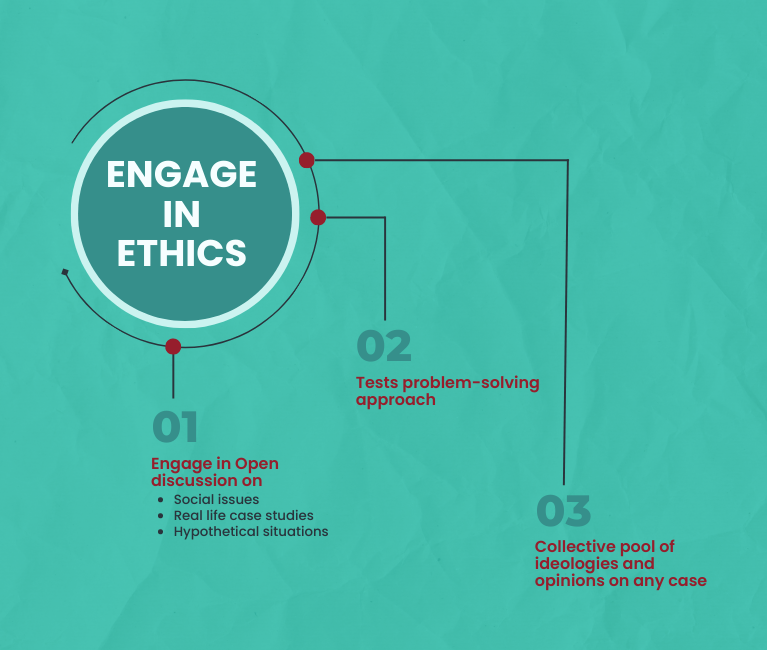
Social Justice
World’s Population Touches 8 Billion
For Prelims: United Nations Population Fund (UNPFA), Mortality Rate, Fertility Rate, Population Growth Rate, Global Population, Replacement-level Fertility
For Mains: Population Distribution, Estimates, Projections and Way Forward
Why in News?
According to the United Nations Population Fund (UNPFA), the human population across the globe touched 8 billion.
- As of 2022, more than half the world’s population lives in Asia, China and India being the two most populous countries with more than 1.4 billion people each.
What are the Trends of Population Growth?
- Overall Decrease in Population Growth Rate:
- According to UN, it took the global population 12 years to grow from 7 billion to 8 billion, it will take approximately 15 years until 2037, for it to reach 9 billion.
- This indicates that overall growth rate of global population is slowing.
- The UN population report said the global population is growing at its slowest rate since 1950, having fallen under 1% in 2020.
- The world’s population could grow to around 8.5 billion in 2030 and 9.7 billion in 2050.
- It is projected to reach a peak of around 10.4 billion people during the 2080s and to remain at that level until 2100.
- According to the UN, 60% of the global population lives in a region where the fertility rate is below replacement level.
- In 1990, 40% lived in a region where fertility rate was below replacement level.
- According to UN, it took the global population 12 years to grow from 7 billion to 8 billion, it will take approximately 15 years until 2037, for it to reach 9 billion.
- High-Fertility Levels in Poor Countries:
- Countries with the highest fertility levels tend to be those with the lowest income per capita.
- More than half of the projected increase in the global population up to 2050 will be concentrated in eight countries: the Democratic Republic of the Congo, Egypt, Ethiopia, India, Nigeria, Pakistan, the Philippines and the United Republic of Tanzania.
- Countries of sub-Saharan Africa are expected to contribute more than half of the increase anticipated through 2050.
- International Migration:
- International migration is now the driver of growth in many countries, with 281 million people living outside their country of birth in 2020.
- All South Asian nations including India, Pakistan, Nepal, Bangladesh and Sri Lanka have seen high levels of emigration in recent years.
What are the Findings about India’s Population?
- Stabilising Population Growth:
- According to UN, India’s fertility rate has hit 2.1 births per woman i.e., replacement-level fertility and is further declining.
- While India’s population growth is stabilising, it is “still growing at 0.7% per year” and is set to surpass China in 2023 as the world’s most populous country.
- According to UN, China's population is no longer growing and may start declining as early as 2023.
- The World Population Prospects 2022, put India’s population estimate at 1.412 billion in 2022, compared with China’s 1.426 billion.
- India is likely to peak at 1.7 billion population in 2048 and then start declining to 1.1 billion at the end of century.
- World’s Largest Adolescent Population:
- According to UNFPA estimates, 68% of India’s population is between 15-64 years old in 2022, while people aged 65 and above comprise 7% of the population.
- Over 27% of the country’s population is between the age of 15-29.
- At 253 million, India is also home to the world’s largest adolescent population (10-19 years).
- India has its largest ever adolescent and youth population.
- India will continue to have one of the youngest populations in the world till 2030 and is currently experiencing a demographic window of opportunity, a “youth bulge” that will last till 2025.
- According to UNFPA estimates, 68% of India’s population is between 15-64 years old in 2022, while people aged 65 and above comprise 7% of the population.
What is the United Nations Population Fund?
- About:
- It is a subsidiary organ of the UN General Assembly and works as a sexual and reproductive health agency.
- The UN Economic and Social Council (ECOSOC) establishes its mandate.
- Establishment:
- It was established as a trust fund in 1967 and began operations in 1969.
- In 1987, it was officially renamed the United Nations Population Fund but the original abbreviation, ‘UNFPA’ for the United Nations Fund for Population Activities was retained.
- Objective:
- UNFPA works directly to tackle Sustainable Development Goals on health (SDG3), education (SDG4) and gender equality (SDG5).
- Funding:
- UNFPA is not supported by the UN budget, instead, it is entirely supported by voluntary contributions of donor governments, intergovernmental organizations, the private sector, foundations and individuals.
Way Forward
- To maximize the potential benefits of a favourable age distribution, countries need to invest in the further development of their human capital by ensuring access to health care and quality education at all ages and by promoting opportunities for productive employment and decent work.
- India is at a stage of demographic transition where mortality rates are declining and fertility rates would decline in the next two to three decades or so. India can now focus on eliminating the need for contraception.
- Women can decide if they want to have children, and if yes, when, how many, and at what intervals.
- For young and adolescent populations, there is a need for skilling, which is the only way to ensure they are more productive and have better incomes.
UPSC Civil Services Examination, Previous Year Questions (PYQ)
Prelims
Q. Which two countries follow China and India in the decreasing order of their populations? (2008)
(a) Brazil and USA
(b) USA and Indonesia
(c) Canada and Malaysia
(d) Russia and Nigeria
Ans: (b)
Exp:
- The 5 most populous countries in descending order are China, India, USA, Indonesia and Brazil.
- Therefore, option B is the correct answer.
Mains
Q1. Discuss the main objectives of Population Education and point out the measures to achieve them in India in detail. (2021)
Q2. ‘’Empowering women is the key to control the population growth.’’ Discuss. (2019)

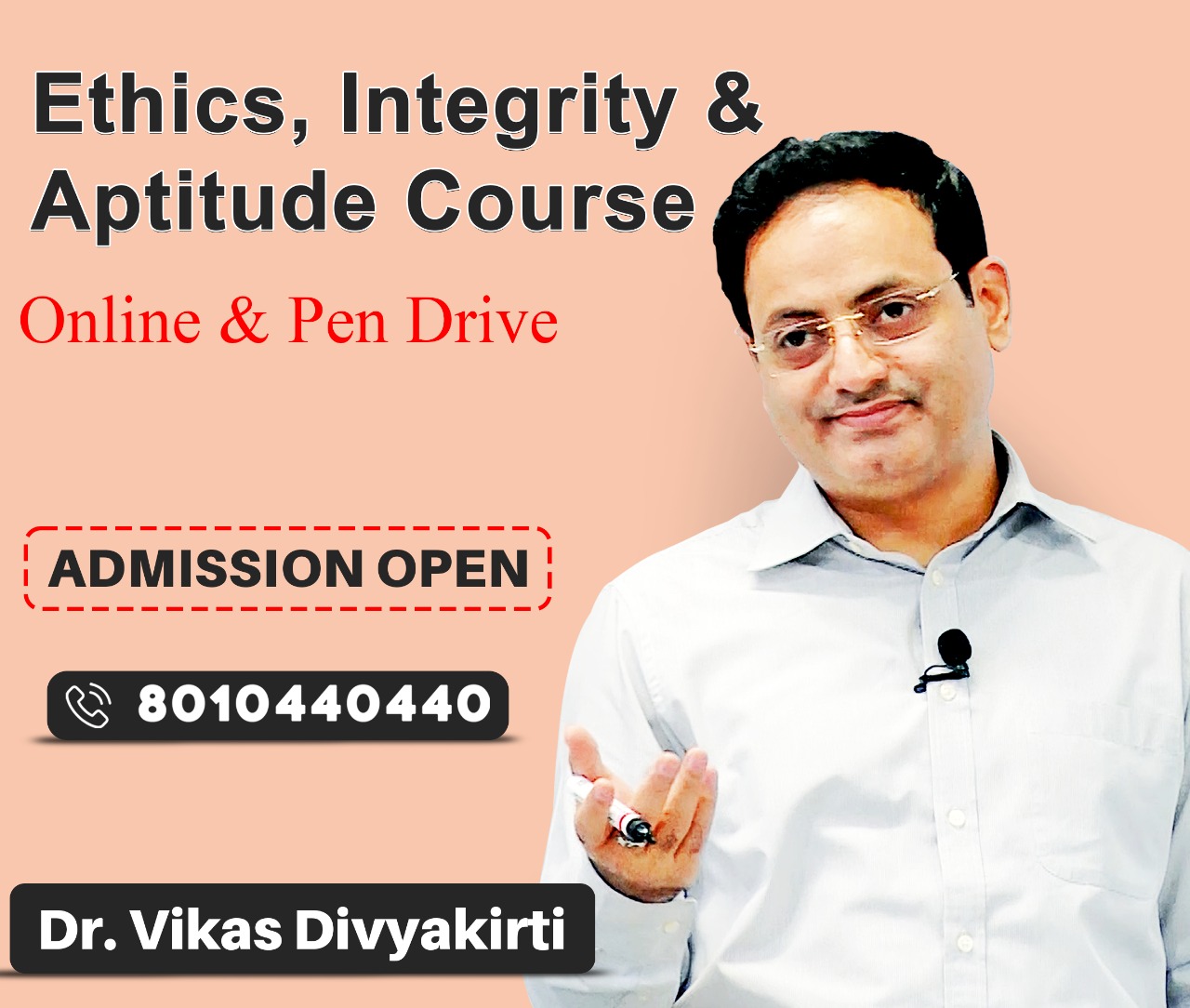
International Relations
G-20 Summit 2022
For Prelims: G-20 Summit, food security, Black Sea grains initiative, Paris Agreement
For Mains: Significance of G20 in India’s Foreign Policy, Groupings & Agreements Involving India and/or Affecting India's Interests
Why in News?
Recently, the 17th annual summit of G-20 was hosted by the Indonesian G20 presidency in Bali under the theme ‘Recover Together, Recover Stronger’.
- Now, India has assumed the charge of the G20 presidency and the 18th summit will be held in India in 2023.
What are the Outcomes of the Summit?
- Condemning Russian Aggression:
- Member countries adopted a declaration deploring Russia's aggression in Ukraine "in the strongest terms" and demanding its unconditional withdrawal.
- They also recognised that while most members condemned the war in Ukraine, "there were other views and different assessments of the situation and sanctions".
- Focus on Global Economy:
- The G20 economies agreed in their declaration to pace interest rate rises carefully to avoid spillovers and warned of "increased volatility" in currency moves, a sea change from last year's focus on mending the scars of the Covid-19 pandemic.
- Food Security:
- The leaders promised to take coordinated action to address food security challenges and applauded the Black Sea grains initiative.
- Climate Change:
- G20 leaders agreed to pursue efforts to limit the global temperature increase to 1.5 degrees Celsius - confirming they stand by the temperature goal from the 2015 Paris Agreement on climate change.
- Digital Transformation:
- Leaders recognised the importance of digital transformation in reaching the sustainable development goals.
- They encouraged international collaboration to further develop digital skills and digital literacy to harness the positive impacts of digital transformation, especially for women, girls, and people in vulnerable situations.
- Health:
- Leaders also expressed their continuous commitment to promoting a healthy and sustainable recovery which builds towards achieving and sustaining universal health coverage.
- They welcomed the establishment of a new financial intermediary fund for pandemic prevention, preparedness and response (the ‘Pandemic Fund’) hosted by the World Bank.
- Leaders reaffirmed their commitment to strengthen global health governance, with the leading and coordination role of World Health Organisation (WHO) and support from other international organisations.
What are the Challenges before the G-20 Member Countries?
- Impact of Russia’s Invasion of Ukraine:
- Russia’s invasion of Ukraine has not only created massive geopolitical uncertainty but also spiked global inflation.
- The associated sanctions by the West have further queered the pitch.
- Persistently high inflation — at historic highs in several countries — has eroded purchasing power across these countries, thus dragging down economic growth.
- Impact of Rising Inflation:
- In response to high inflation, central banks across countries have raised interest rates, which, in turn, have dampened economic activity further.
- Some of the biggest major economies such as the US and the UK are set to face a recession; others, such as those in the euro area, are likely to slow down to almost a halt.
- Slowdown of Major Economies:
- China, one of the major engines for global growth, is witnessing a sharp slowdown as it struggles with a real estate crisis.
- Rising Geopolitical Rifts:
- The world economy is struggling with geopolitical rifts such as the tensions between the US and China, the two biggest economies in the world, or the decline in trade between the UK and the euro area in the wake of the Brexit decision.
What is the G20?
- About:
- The G20 was formed in 1999 in the backdrop of the financial crisis of the late 1990s that hit East Asia and Southeast Asia in particular.
- It aims to secure global financial stability by involving middle-income countries.
- Together, the G20 countries include 60% of the world’s population, 80% of global GDP, and 75% of global trade.
- Members:
- Argentina, Australia, Brazil, Canada, China, France, Germany, India, Indonesia, Italy, Japan, Republic of Korea, Mexico, Russia, Saudi Arabia, South Africa, Turkey, the United Kingdom, the United States and the EU.
Way Forward
- The first job at hand for the G-20 Countries is to contain raging inflation.
- But at the same time, governments have to find ways to help the vulnerable without necessarily ballooning the debt levels. A key concern in this regard would be to ensure that external risks are carefully monitored.
- A strong, sustainable, balanced, and inclusive recovery requires joint action by the G-20 and this kind of joint action, in turn, requires not just securing peace in Ukraine but also “help prevent further fragmentation”.
- On trade, the G20 leaders need to push for a “more open, stable, and transparent rules-based trade” that would help address global shortages of goods.
- Strengthening the resilience of global value chains would help protect against future shocks.
UPSC Civil Services Examination, Previous Year Question (PYQ)
Q. In which one of the following groups are all the four countries members of G20?
(a) Argentina, Mexico, South Africa and Turkey
(b) Australia, Canada, Malaysia and New Zealand
(c) Brazil, Iran, Saudi Arabia and Vietnam
(d) Indonesia, Japan, Singapore and South Korea
Ans: (a)
Exp:
- The G20 is an informal group of 19 countries and the European Union, with representatives of the International Monetary Fund and the World Bank.
- In order to achieve a robust global economic growth, the member countries which represent and contribute more than 80% of the global GDP came at the premier forum for international economic cooperation, which was agreed by leaders at the Pittsburgh Summit in Pennsylvania (USA) in September 2009.
- The G20 members include Argentina, Australia, Brazil, Canada, China, France, Germany, India, Indonesia, Italy, Japan, Mexico, Republic of Korea , Russia, Saudi Arabia, South Africa, Turkey, the United Kingdom, the United States and the European Union (EU).
- Therefore, option (a) is the correct answer.


Social Justice
Sugamya Bharat Abhiyan
For Prelims: Accessible India Campaign, Government’s Initiatives for Person with Disabilities
For Mains: Performance of Accessible Indian Campaign, Related Initiatives
Why in News?
The Sugamya Bharat Abhiyan (Accessible India Campaign) is going to complete 7 years in December 2022.
- The aim of the Campaign is to make a barrier-free and conducive environment for Divyangjans (Persons with Disabilities - PwDs) all over the country.
What is the Accessible India Campaign?
- About:
- It was launched by the Prime Minister of India on International Day of Persons with Disabilities on 3rd December 2015.
- Implementing Agency:
- AIC is the nationwide flagship campaign of the Department of Empowerment of Persons with Disabilities (DEPwD), Ministry of Social Justice and Empowerment.
- Background:
- Persons with Disabilities (Equal Opportunities, Protection of Rights and Full Participation) Act, 1995 categorically provided for non-discrimination in transport and in the built environment.
- It needs to be noted that the Rights of Persons with Disabilities Act, 2016 replaced the PwD Act, 1995 to comply with United Nations Convention on the Rights of Persons with Disabilities (UNCRPD) .
- UNCRPD, to which India is a signatory, under Article 9 casts obligations on the Governments for ensuring to PwDs accessibility to:
- Information
- Transportation
- Physical Environment
- Communication Technology
- Accessibility to Services as well as emergency services.
- Persons with Disabilities (Equal Opportunities, Protection of Rights and Full Participation) Act, 1995 categorically provided for non-discrimination in transport and in the built environment.
- Components of AIC:
- Built Environment Accessibility
- Transportation System Accessibility
- Information and Communication Eco-System Accessibility
How has the Accessible India Campaign Performed?
- Built-Up Environment:
- Access Audit of 1671 buildings completed.
- 1,630 Government buildings, including 1030 Central Government buildings have been provided with features of accessibility.
- Transportation Sector:
- Airports:
- 35 International Airports and 55 Domestic Airports have been provided with features of accessibility.
- Ambulifts are available at 12 airports.
- Railways:
- All 709 A1, A & B category railway stations have been provided with seven Short Term Facilities.
- 603 railway stations have been provided with 2 Long Term Facilities.
- Roadways:
- 1,45,747 (29.05%) buses have been made partially accessible and 8,695 (5.73%) made fully accessible
- Airports:
- ICT Ecosystem (Websites):
- Nearly 627 Central and State/UT government websites have been made accessible.
- Accessibility in TV viewing:
- 19 private news channels are telecasting partially accessible news bulletins.
- 2,447 news bulletins have been telecast with subtitling/sign-language interoperation.
- 9 general entertainment channels have telecast 3686 scheduled programs/movies using subtitling
- Education:
- Out of 11,68,292 government and government aided schools, 8,33,703 schools (71%) have been made barrier free with the provision of ramps, handrails and accessible toilets
- Monitoring:
- Activities under the Accessible India Campaign are being monitored through a Management Information System (MIS) portal.
- Sugamya Bharat App:
- Helping in crowdsourcing grievances of accessibility being faced on ground in infrastructure and services and forwarding for redressal.
- Helpful in creating sensitization and awareness generation about importance of accessibility.
- COVID-19 related complaints which are meant only for Divyangjans are being given top priorities.
What are the Recent Initiatives to Empowerment of Disables?
- India:
- Global:
UPSC Civil Services Examination, Previous Year Question (PYQ)
Q. Does the Rights of Persons with Disabilities Act, 2016 ensure effective mechanism for empowerment and inclusion of the intended beneficiaries in the society? Discuss. (2017)


Indian History
Janjatiya Gaurav Divas
For Prelims: Janjatiya Gaurav Divas, Khasis, Bhils, Mizos, Sidhu and Kanhu Murmu,Birsa Munda, Shaheed Veer Narayan Singh
For Mains: Tribal Leaders and Freedom Movements
Why in News?
Recently, the President of India on the occasion of the Janjatiya Gaurav Divas (15th November 2022) paid tribute to the freedom fighter Bhagwan Birsa Munda on his birth anniversary.
Why do we Celebrate Janjatiya Gaurav Divas?
- The Janjatiya Gaurav Divas is celebrated every year to recognize the efforts of the tribals in the preservation of cultural heritage and promotion of Indian values of national pride, valour, and hospitality.
- Tribals held several tribal movements across different regions of India against the British colonial rule. These tribal communities include Tamars, Santhals, Khasis, Bhils, Mizos, and Kols to name a few.
Who were the Tribal Freedom Fighters?
- Birsa Munda:
- Birsa Munda born on 15th November 1875 was a member of the Munda Tribe of the Chhota Nagpur Plateau.
- He was an Indian freedom fighter, religious leader, and folk hero.
- He spearheaded an Indian tribal religious Millenarian movement during British rule in the late 19th century across the tribal belt of modern-day Jharkhand and Bihar.
- Birsa was a close observer of the Sardari Larai movement in the region in the 1880s, which sought to restore tribal rights through nonviolent means such as petitioning the British government. These demands, however, were ignored by the harsh colonial authority.
- The tribals were quickly demoted from landowners to labourers under the zamindari system, which resulted in Birsa taking up the cause of the Adivasis.
- Birsa Munda went on to form Birsait, a new religion.
- The religion preached the belief in a single God and urged people to return to their old religious convictions. People began to refer to him as a cost-effective religious healer, a miracle worker, and a preacher.
- People from Oraon and Munda became convinced Birsaites, and many began calling him 'Dharti Abba, meaning Father of the Earth.' He brought a fresh perspective to the religious realm.
- Birsa Munda led the rebellion that came to be known as Ulgulan (revolt) or the Munda rebellion against the British government-imposed feudal state system.
- He awakened the masses and sowed the seeds of revolt in them against the landlords as well as the Britishers.
- His struggle against the exploitation and discrimination against tribals led to the passing of the Chotanagpur Tenancy Act in 1908 which restricted the passing of land from the tribal people to non-tribals.
- Shaheed Veer Narayan Singh:
- He is considered the Pride of Sonakhan in Chhattisgarh, he looted trader’s grain stock and distributed them amongst the poor after the 1856 famine.
- The sacrifice of Veer Narayan Singh made him a tribal leader and he became the first martyr from Chhattisgarh in the independence struggle of 1857.
- Shri Alluri Seetha Ram Raju:
- He was born on 4th July, 1897 in a village called Mogallu near Bhimavaram in Andhra Pradesh.
- Alluri is best remembered for leading the Rampa Rebellion against the British in which he organised the tribal people of Visakhapatnam and East Godavari districts to revolt against the foreigners.
- He was inspired by the revolutionaries of Bengal to fight against the British government.
- Rani Gaidinliu:
- She was a Naga spiritual and political leader who led a revolt against British rule in India. At the age of 13, she joined the Heraka religious movement of her cousin Haipou Jadonang.
- For her, the Naga people’s journey to freedom was part of India’s wider movement for freedom. She also spread the message of Gandhi ji in Manipur region.
- Sidhu and Kanhu Murmu:
- On 30th June 1855, two years before the Great Revolt of 1857, two Santhal brothers Sidhu and Kanhu Murmu organised 10,000 Santhals and proclaimed a rebellion against the British.
- The tribals took an oath to drive away from the British from their homeland. The Murmu brothers’ sisters Phulo and Jhano also played an active part in the rebellion.
UPSC Civil Services Examination Previous Year Questions (PYQ)
Q. With reference to the history of India, “Ulgulan” or the Great Tumult is the description of which of the following events? (2020)
(a) The Revolt of 1857
(b) The Mappila Rebellion of 1921
(c) The Indigo Revolt of 1859-60
(d) Birsa Munda’s Revolt of 1899-1900
Ans: (d)


Economy
Friendshoring
For Prelims: Friendshoring, Ally shoring, Protectionism, Deglobalisation.
For Mains: Implications of Friendshoring.
Why in News?
Recently, the US secretary of treasury has pushed for "friendshoring" to diversify trade away from countries that are present at geopolitical risk.
What is Friendshoring?
- Friendshoring is a strategy where a country sources the raw materials, components and even manufactured goods from countries that share its values. The dependence on the countries considered a "threat" to the stability of the supply chains is slowly reduced.
- It is also called "allyshoring".
- For the US, Russia has long presented itself as a reliable energy partner, but in the Ukraine war, it has weaponized the gas against the people of Europe.
- It's an example of how malicious actors can use their market positions to try to gain geopolitical leverage or disrupt trade for their own gain.
- For the US, Russia has long presented itself as a reliable energy partner, but in the Ukraine war, it has weaponized the gas against the people of Europe.
- Friend-shoring or ally-shoring has become a means for the US to influence firms to move their sourcing and manufacturing sites to friendly shores—often back to the same shores in the case of the US.
- The purpose of Frienshoring is to insulate countries’ supply chains from less like-minded nations, such as China in case of the US.
What can be the Implications of Friendshoring?
- Friendshoring may push the world towards a more isolated place for trade and reverse the gains of globalization. It is a part of the "deglobalisation" process.
- After the global economy has been influenced by the years-long lockdown of Covid-19, any form of protectionism will further disrupt the already unstable global supply chain.
- This new form of protectionism will not be conducive to globalization while affecting the global supply chain and economy. And in the long term, this could backfire if a company relies on some country—for lithium for batteries, say, or precious metals for computer chips—feels alienated.
- Also, as this becomes a trend, the world will gradually be separated, and it will be hard for countries to work together for the well-being of humanity.
Conclusion
- Today’s world has reached its prime by countries working together.
- By having each country use its best advantage to contribute to the world’s economy, everyone’s disadvantage gets compensated.
- Although we are still way far from complete globalization, and there are many differences and even controversies between countries, still, friend-shoring does not seem like a good solution for a better future for the global supply chain.

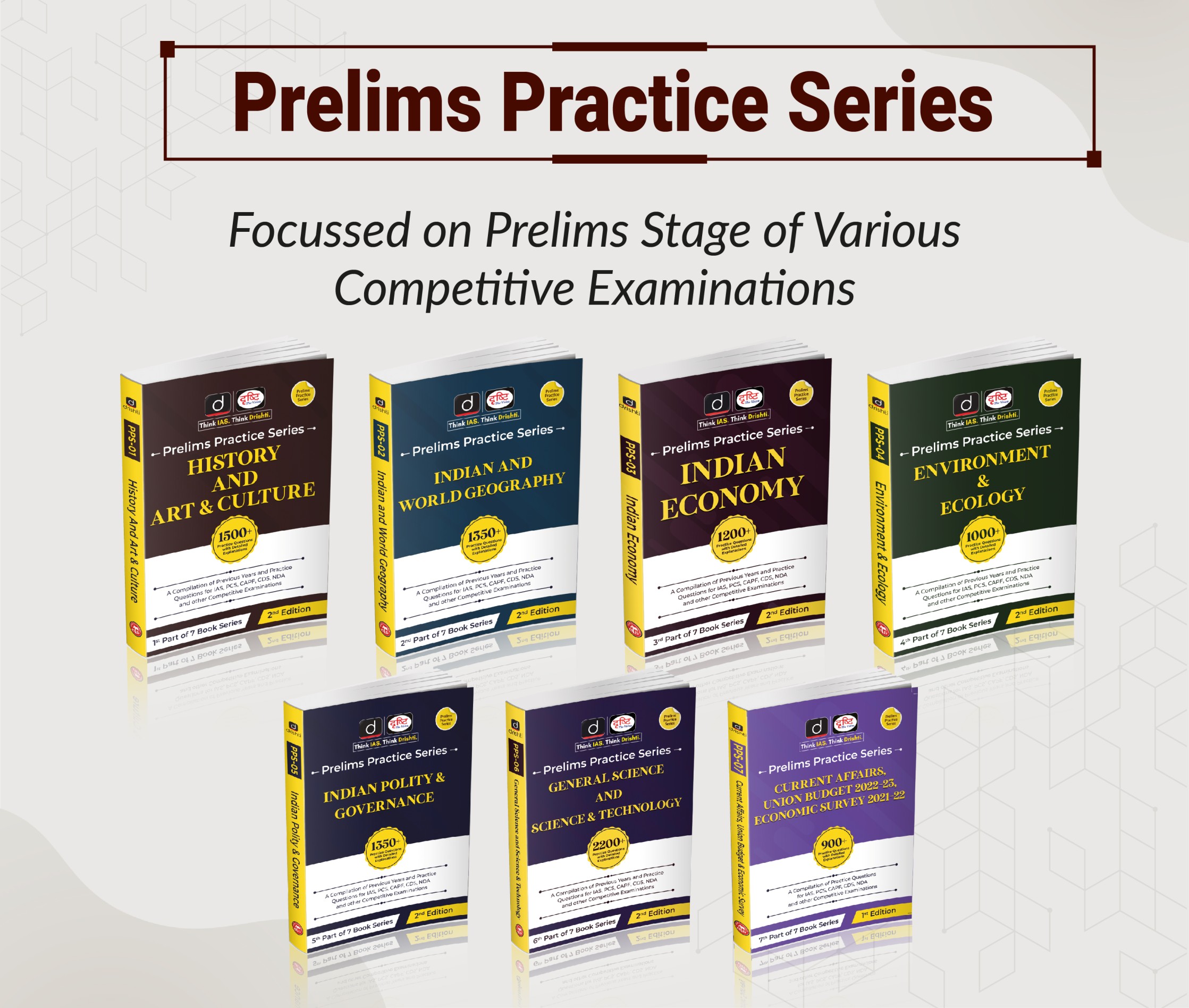
Important Facts For Prelims
Patan Patola
Why in News?
Recently, Prime Minister of India gifted a ‘Patan Patola’ scarf to the Prime Minister of Italy at the G20 summit.
What is Patan Patola?
- Patola is a double ikat woven fabric, usually made from silk in Patan (North Gujarat).
- Ikat is a method of tie-dyeing the warp or weft before the cloth is woven.
- It received a Geographical Indication (GI) tag in 2013.
- The ancient art of double ikat or Patola woven in pure silk dates back to the 11th century.
- This peculiar quality has its origins in an intricate and difficult technique of dyeing or knot dyeing, known as ‘bandhani’, on the warp and weft separately before weaving.
- The Patola fabrics bear an equal intensity of colours and design on both sides.
- Patola is woven on primitive hand-operated harness looms made out of rosewood and bamboo strips. The loom lies on a slant.
- The process is labour-intensive, time-consuming, and requires a high order of skill and expertise
- It takes three to four months to prepare a tie-died design on warp and weft threads for one saree of six yards.
- While possessing and wearing a Patola is considered a matter of pride, the fabric has largely remained inaccessible to common people because of its high price.
- One of the major practitioners of this art form is the Salvi family from Patan.
- The other commonly worn Patola is the Rajkot Patola, woven on a flat loom.
- Before World War II, Indonesia was the major buyer of Patolas.
Source: IE


Important Facts For Prelims
Digital Shakti 4.0
Why in News?
The National Commission for Women (NCW) has recently launched the fourth phase of the Digital Shakti Campaign.
- NCW launched it in collaboration with CyberPeace Foundation and Meta.
What is Digital Shakti?
- About:
- Digital Shakti started in June 2018 to help women across the nation to raise the awareness level on the digital front.
- It is helping women in reporting & redressal mechanisms, data privacy and usage of technology for their benefits.
- The third phase of the program was started in March 2021 with the launch at Leh.
- Digital Shakti 4.0:
- Digital Shakti 4.0 is focused on making women digitally skilled and aware to stand up against any illegal/inappropriate activity online.
- It aims to ensure safe cyber spaces for women.
- Achievements:
- Through the Digital Shakti project, over 3 Lakh women across India have been made aware of cyber safety tips and tricks, reporting & redressal mechanisms, data privacy and usage of technology for their benefits.
What is National Commission for Women?
- It was set up as a statutory body in January 1992 under the National Commission for Women Act, 1990.
- Its mission is to strive towards enabling women to achieve equality and equal participation in all spheres of life by securing her due rights and entitlements through suitable policy formulation, legislative measures, etc.
- Its functions are to:
- Review the constitutional and legal safeguards for women.
- Recommend remedial legislative measures.
- Facilitate redressal of grievances.
- Advise the Government on all policy matters affecting women.



